Left Ventricular Assist Devices Market Size
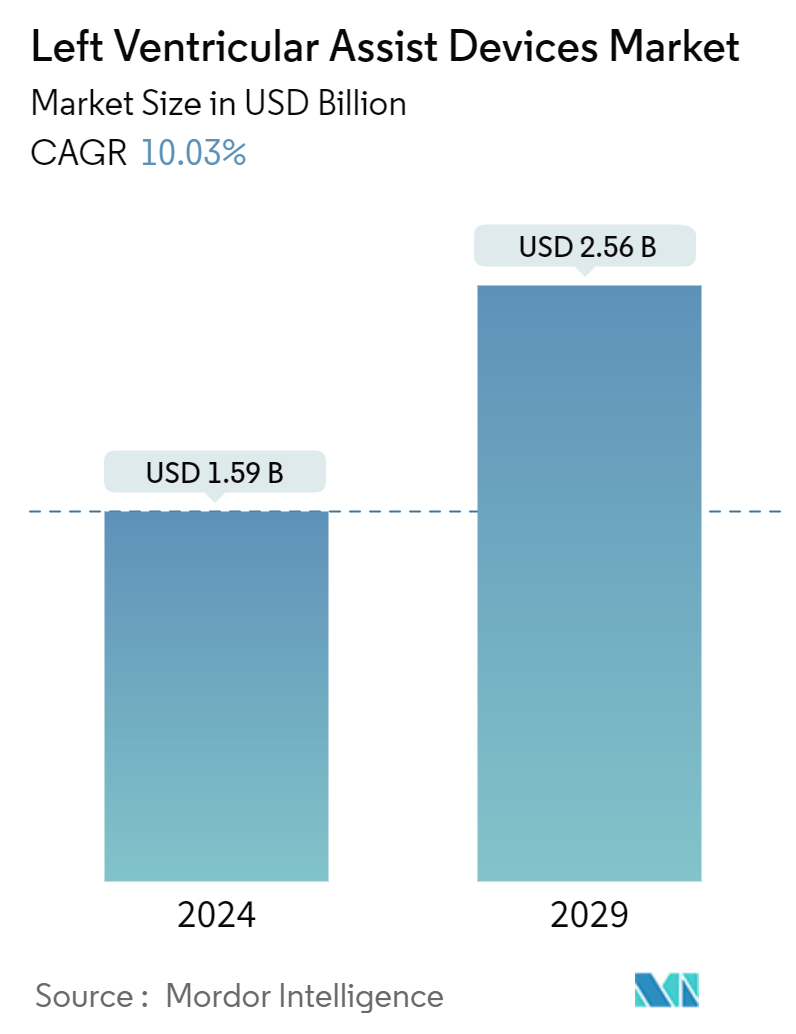
| Study Period | 2019 - 2029 |
| Market Size (2024) | USD 1.59 Billion |
| Market Size (2029) | USD 2.56 Billion |
| CAGR (2024 - 2029) | 10.03 % |
| Fastest Growing Market | Asia Pacific |
| Largest Market | North America |
Major Players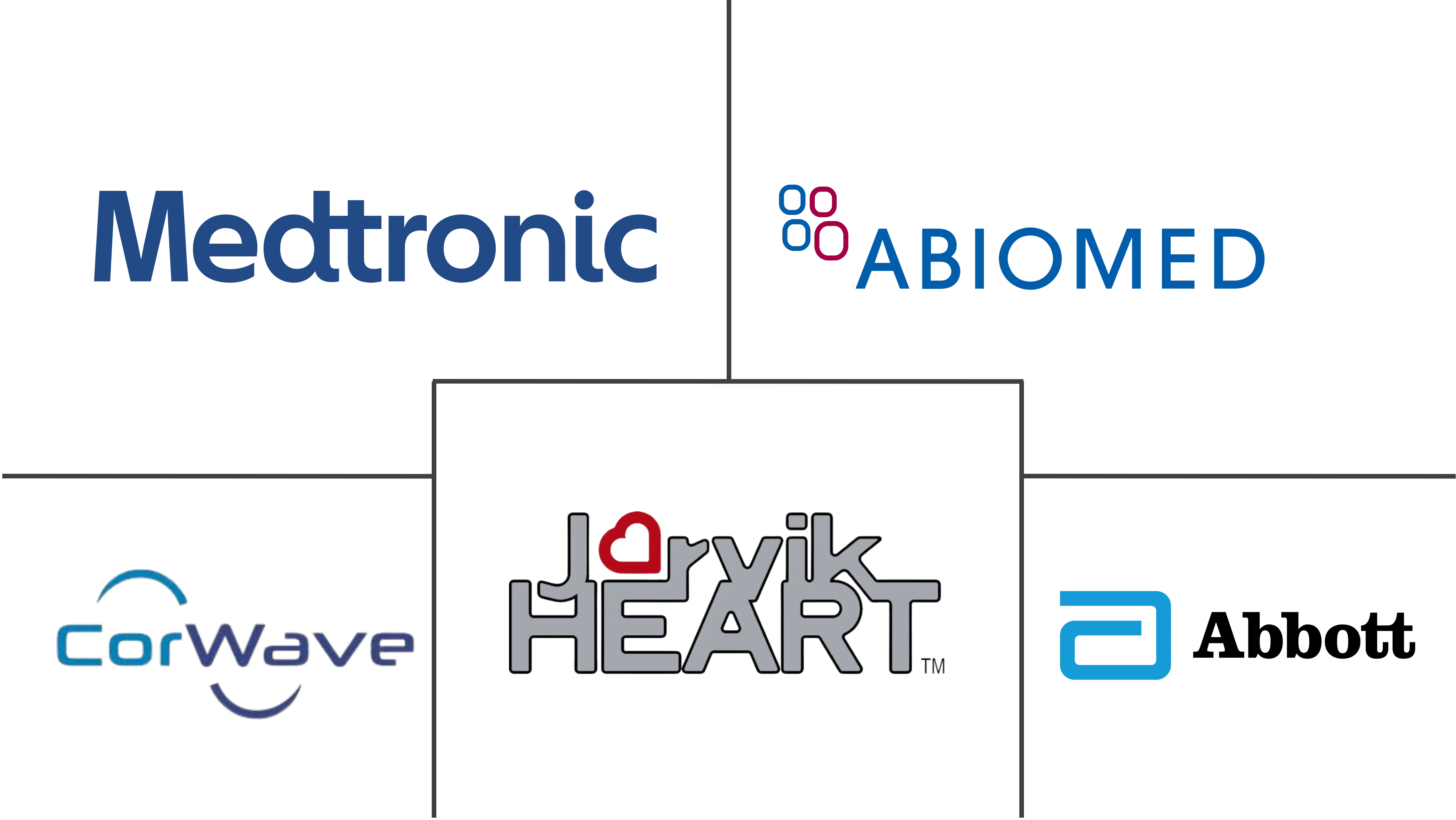
*Disclaimer: Major Players sorted in no particular order |
Left Ventricular Assist Devices Market Analysis
The Left Ventricular Assist Devices Market size is estimated at USD 1.59 billion in 2024, and is expected to reach USD 2.56 billion by 2029, growing at a CAGR of 10.03% during the forecast period (2024-2029).
Factors such as the growing burden of cardiac diseases and heart failure, technological advancement of devices for cardiac disease management, and growing initiatives and awareness regarding cardiovascular diseases are expected to boost the growth of the left ventricular assist devices market.
As global cardiovascular diseases surge, especially among aging populations and those with rising risk factors like hypertension and diabetes, the demand for advanced treatments, including left ventricular assist devices (LVADs), is set to grow. For instance, data from the Journal of Cardiac Failure in October 2023 highlighted that approximately 6.7 million Americans aged 20 and older are currently grappling with heart failure. Projections indicate this figure could escalate to 8.5 million by 2030. Notably, the lifetime incidence of heart failure (HF) has climbed to 24%, suggesting that roughly one in four individuals will confront HF at some point in their lives. LVADs emerge as a crucial alternative for patients with severe heart failure who aren't candidates for heart transplantation. This underscores the rising demand for LVADs, whether as a bridge to transplantation or as a standalone therapy, fueling the market's expansion.
Heart failure stands as a significant global health challenge, ranking among the top causes of mortality. Certain biosensors are adept at detecting these critical changes. It is essential to integrate these biosensors into mechanical circulatory support devices (MCSDs), such as left ventricular assist devices (LVADs), to monitor biochemical and physiological shifts after implantation. Various studies were conducted to assess the integration of biosensors in left ventricular assist devices.
For instance, a June 2024 article in Heart Failure Reviews underscored the potential of innovative passive radio frequency-based sensors paired with LVADs for the early detection of physiological changes. Consequently, the early detection of cardiovascular diseases by using biosensor-integrated LVADs is expected to drive the demand for these devices in the market, propelling the market's growth during the forecast period.
Furthermore, key players are ramping up research and development activities related to LVADs, paving the way for innovative devices in the market. This surge in innovation is expected to propel the market's growth during the forecast period. For instance, in June 2023, Magenta Medical, an Israeli medical device company, introduced an early feasibility study for its Elevate Percutaneous Left Ventricular Assist Device (VAD), targeting high-risk percutaneous coronary intervention (HR-PCI). The Elevate device marks a departure from traditional LVADs, which are large and necessitate open-heart surgery for implantation. Instead, Elevate is introduced via a minor groin puncture and expands once it reaches the heart's left ventricle. This breakthrough signifies a major advancement in cardiac care, potentially offering patients less invasive options for advanced cardiovascular support. Thus, the heightened focus on the Elevate Percutaneous Left Ventricular Assist Device (VAD) underscores its potential to drive the market's growth in the coming years.
Therefore, owing to the rising burden of cardiovascular disease and heart failure, increasing technological advancements in left ventricular assist devices, and growing company activities to conduct various research studies, the studied market is expected to grow during the forecast period. However, the high cost of devices and procedures and the severe risk associated with LVAD implants are likely to impede the market's growth during the forecast period.
Left Ventricular Assist Devices Market Trends
The Centrifugal Flow Segment is Expected to Witness Significant Growth During the Forecast Period
Centrifugal flow left ventricular assist devices utilize a spinning impeller to ensure a steady blood flow from the left ventricle to the aorta. This method stands in contrast to axial flow left ventricular assist devices, which employ a distinct mechanism for blood movement. Centrifugal flow left ventricular assist devices present numerous benefits for patients facing cardiac failure or arrest. These devices ensure a steady and efficient blood flow, catering to patients with diverse cardiac output levels. Their straightforward design, often featuring fewer moving parts than axial flow counterparts, may enhance reliability.
The centrifugal flow left ventricular assist devices segment is expected to witness significant growth during the forecast period owing to factors such as the high burden of heart failure and cardiac diseases, advantages offered by centrifugal flow left ventricular assist devices, and the rising number of research studies.
Numerous studies have delved into the potential and long-term outcomes of fully magnetically centrifugal left ventricular assist devices. For instance, a February 2024 article in the European Heart Journal spotlighted real-world insights from the ELEVATE registry. The findings revealed a 63.3% overall survival rate for primary implants of the fully magnetically centrifugal left ventricular assist devices. Moreover, patients with advanced heart failure in the primary implant group experienced fewer adverse events during extended follow-ups and reported enhanced quality of life and functional capacity after five years. As the proven effectiveness of centrifugal left ventricular assist devices comes to light, a surge in their adoption is anticipated, propelling growth in this segment.
Given the myriad advantages of centrifugal flow left ventricular assist devices and the increasing volume of research validating their efficacy for cardiovascular patients, this segment is set for growth in the foreseeable future.
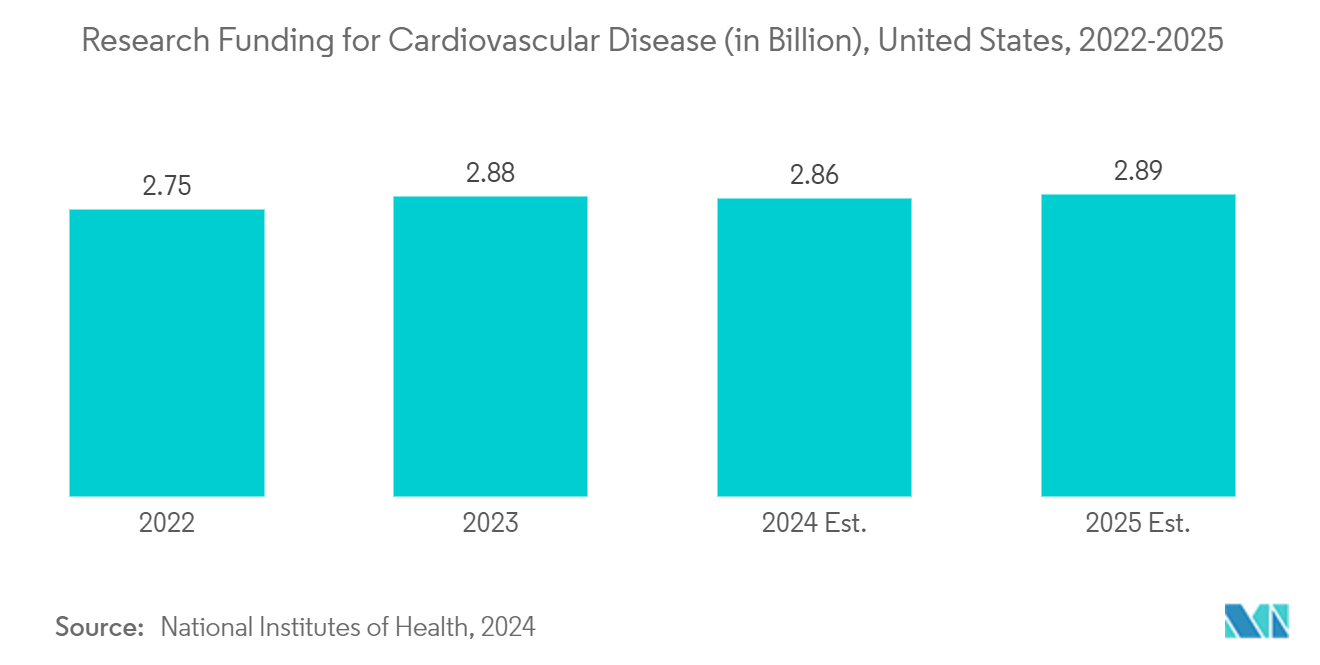
North America is Expected to Hold a Significant Share in the Market During the Forecast Period
North America is poised for substantial growth during the forecast period, driven by the rising prevalence of cardiovascular diseases and proactive R&D initiatives by leading market players.
In the United States, the rising incidents of out-of-hospital cardiac arrests (OHCA) underscore the urgent need for effective interventions to boost survival rates and improve long-term outcomes. For instance, data from the United States Centers for Disease Control and Prevention (CDC) in May 2024 reveals that annually, over 356,000 individuals in the United States face an out-of-hospital cardiac arrest. Consequently, this high number of OHCA cases is set to propel the growth of the left ventricular assist devices market, driven by a heightened demand for advanced cardiac support solutions.
Additionally, as heart attack incidents rise, the demand for cutting-edge medical interventions like left ventricular assist devices (LVADs) increases, further bolstering the market growth. For instance, according to the Centers for Disease Control and Prevention, in May 2024, around 805,000 individuals in the United States suffered a heart attack annually. Of these, 605,000 experience it for the first time, while 200,000 have a prior history. Given the significant impact of myocardial infarctions on the population, the demand for innovative solutions like LVADs is projected to surge during the forecast period.
Furthermore, key players are increasingly collaborating, a trend poised to drive the development of innovative left ventricular assist devices (LVADs) in the market. This momentum is set to fuel the market's growth during the forecast period. For instance, in December 2023, Tampa General Hospital (TGH), in partnership with USF Health Morsani College of Medicine, successfully implanted its 500th HeartMate Left Ventricular Assist Device (LVAD). Notably, this device stands out as the sole, durable pump in the United States with implantation approval, marking it as the pinnacle of advancement in its domain.
Therefore, owing to factors such as the high burden of cardiovascular diseases among the population and collaboration strategies adopted by hospitals and colleges, the studied market is expected to grow during the forecast period.
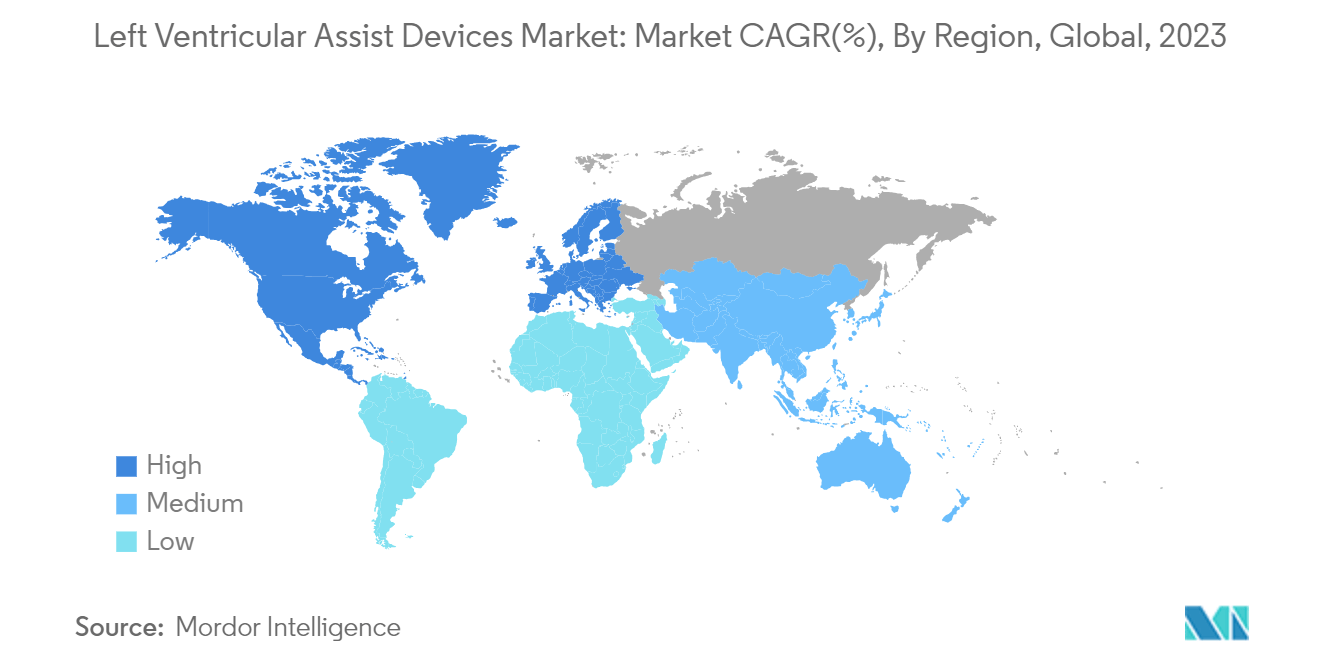
Left Ventricular Assist Devices Industry Overview
The left ventricular assist devices market is consolidated, with a few major companies dominating the industry. These dominating players hold a significant share of the market due to their advanced technology, established market presence, and extensive clinical data supporting their devices. Some of the key players in the market are Medtronic, Abbott, Abiomed Inc., Jarvik Heart Inc., and CorWave SA.
Left Ventricular Assist Devices Market Leaders
-
Medtronic
-
Abbott
-
Abiomed Inc.
-
Jarvik Heart Inc.
-
CorWave SA
*Disclaimer: Major Players sorted in no particular order
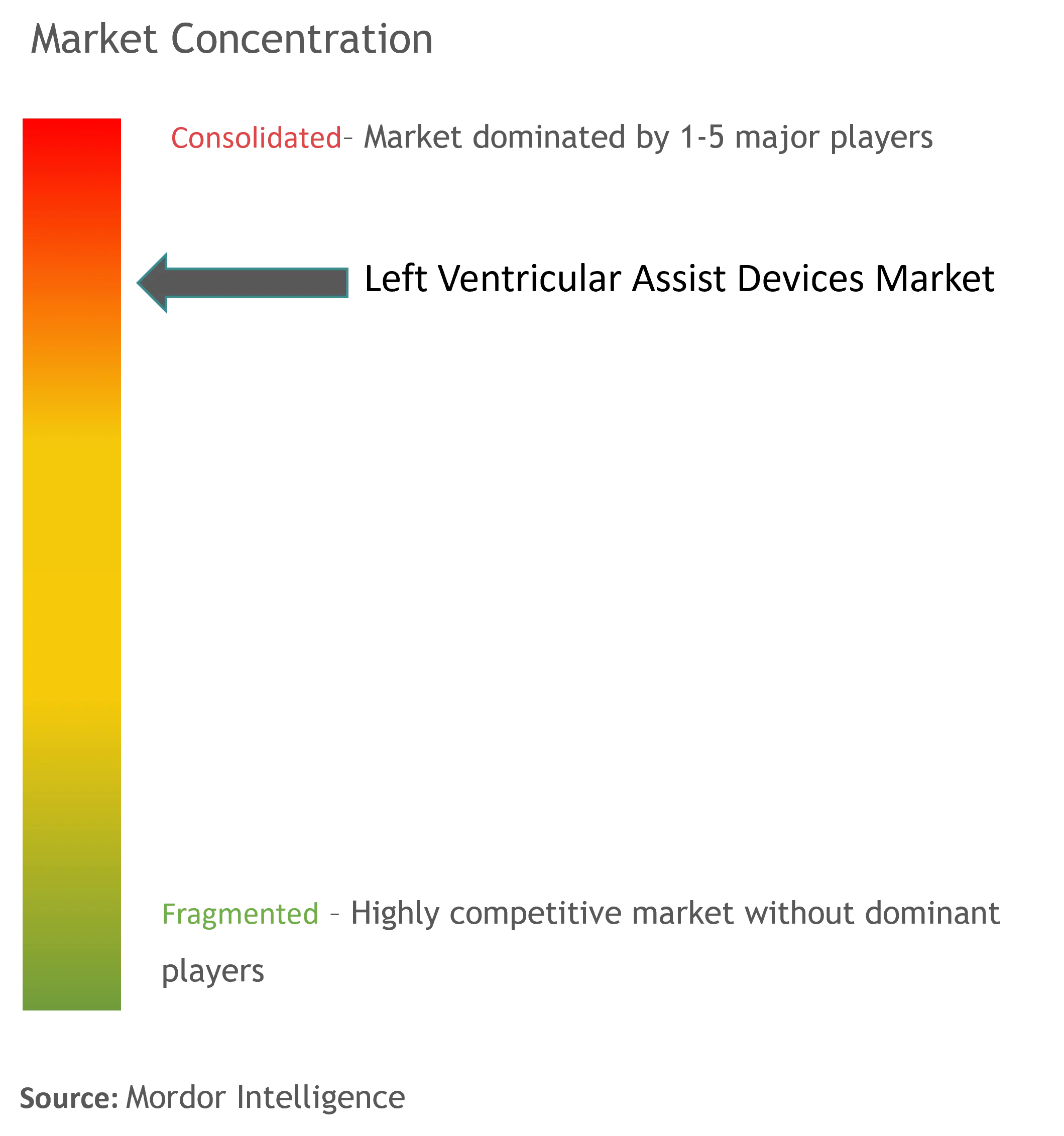
Left Ventricular Assist Devices Market News
- June 2024: IIT Kanpur developed a ground-breaking titanium artificial heart, a Left Ventricular Assist Device (LVAD) engineered from titanium, which offers a crucial lifeline for individuals with heart failure.
- February 2024: The Australian Government invested USD 50 million in technology for the development of advanced artificial hearts (left ventricular assist devices) to reduce heart failure cases globally.
Left Ventricular Assist Devices Market Report - Table of Contents
1. INTRODUCTION
- 1.1 Study Assumptions and Market Definition
- 1.2 Scope of the Study
2. RESEARCH METHODOLOGY
3. EXECUTIVE SUMMARY
4. MARKET DYNAMICS
- 4.1 Market Overview
-
4.2 Market Drivers
- 4.2.1 Increasing Burden of Cardiac Diseases and Heart Failures
- 4.2.2 Technological Advancements of Devices for Cardiac Diseases Management
- 4.2.3 Growing Initiatives and Awareness Regarding Cardiovascular Diseases
-
4.3 Market Restraints
- 4.3.1 High Costs of Devices and Procedures
- 4.3.2 Severe Risks Associated with LVAD Implant
-
4.4 Porter's Five Forces Analysis
- 4.4.1 Threat of New Entrants
- 4.4.2 Bargaining Power of Buyers/Consumers
- 4.4.3 Bargaining Power of Suppliers
- 4.4.4 Threat of Substitute Products
- 4.4.5 Intensity of Competitive Rivalry
5. MARKET SEGMENTATION (Market Size by Value - USD)
-
5.1 By Technology
- 5.1.1 Centrifugal Flow
- 5.1.2 Axial Flow
-
5.2 By Therapy
- 5.2.1 Bridge-to-Transplant (BTT) Therapy
- 5.2.2 Destination Therapy
- 5.2.3 Other Therapy (Bridge-to-recovery (BTR) Therapy and Bridge-to-Candidacy (BTC))
-
5.3 By End User
- 5.3.1 Hospitals
- 5.3.2 Specialty Clinics
- 5.3.3 Ambulatory Surgical Centers
-
5.4 Geography
- 5.4.1 North America
- 5.4.1.1 United States
- 5.4.1.2 Canada
- 5.4.1.3 Mexico
- 5.4.2 Europe
- 5.4.2.1 Germany
- 5.4.2.2 United Kingdom
- 5.4.2.3 France
- 5.4.2.4 Italy
- 5.4.2.5 Spain
- 5.4.2.6 Rest of Europe
- 5.4.3 Asia-Pacific
- 5.4.3.1 China
- 5.4.3.2 Japan
- 5.4.3.3 India
- 5.4.3.4 Australia
- 5.4.3.5 South Korea
- 5.4.3.6 Rest of Asia-Pacific
- 5.4.4 Middle East and Africa
- 5.4.4.1 GCC
- 5.4.4.2 South Africa
- 5.4.4.3 Rest of Middle East and Africa
- 5.4.5 South America
- 5.4.5.1 Brazil
- 5.4.5.2 Argentina
- 5.4.5.3 Rest of South America
6. COMPETITIVE LANDSCAPE
-
6.1 Company Profiles
- 6.1.1 Abiomed Inc.
- 6.1.2 Abbott
- 6.1.3 Berlin Heart GmbH
- 6.1.4 Jarvik Heart Inc.
- 6.1.5 Medtronic PLC
- 6.1.6 Terumo Corporation
- 6.1.7 CorWave SA
- 6.1.8 Evaheart Inc.
- 6.1.9 LivaNova
- *List Not Exhaustive
7. MARKET OPPORTUNITIES AND FUTURE TRENDS
** Subject To AvailablityLeft Ventricular Assist Devices Industry Segmentation
As per the scope of the report, left ventricular assist devices (LVADs) are mechanical pumps designed to aid heart function in individuals suffering from severe heart failure. These devices assist the left ventricle in pumping blood throughout the body, compensating for its weakened state. While LVADs primarily serve as a bridge to heart transplantation, they also function as a long-term therapy for patients deemed ineligible for a transplant. Typically, the LVAD setup includes a pump implanted within the chest, complemented by an externally worn controller and power sources.
The left ventricular assist devices market is segmented into technology, therapy, and geography. By technology, the market is segmented into centrifugal flow and axial flow. By therapy, the market is segmented into bridge-to-transplant (BTT) therapy, destination therapy, and other therapies. By end user, the market is segmented into hospitals, specialty clinics, and ambulatory surgical centers. By geography, the market is segmented into North America, Europe, Asia-Pacific, Middle East and Africa, and South America. For each segment, the market sizing and forecasts were made based on value (USD).
| By Technology | Centrifugal Flow | |
| Axial Flow | ||
| By Therapy | Bridge-to-Transplant (BTT) Therapy | |
| Destination Therapy | ||
| Other Therapy (Bridge-to-recovery (BTR) Therapy and Bridge-to-Candidacy (BTC)) | ||
| By End User | Hospitals | |
| Specialty Clinics | ||
| Ambulatory Surgical Centers | ||
| Geography | North America | United States |
| Canada | ||
| Mexico | ||
| Geography | Europe | Germany |
| United Kingdom | ||
| France | ||
| Italy | ||
| Spain | ||
| Rest of Europe | ||
| Geography | Asia-Pacific | China |
| Japan | ||
| India | ||
| Australia | ||
| South Korea | ||
| Rest of Asia-Pacific | ||
| Geography | Middle East and Africa | GCC |
| South Africa | ||
| Rest of Middle East and Africa | ||
| Geography | South America | Brazil |
| Argentina | ||
| Rest of South America |
Left Ventricular Assist Devices Market Research FAQs
How big is the Left Ventricular Assist Devices Market?
The Left Ventricular Assist Devices Market size is expected to reach USD 1.59 billion in 2024 and grow at a CAGR of 10.03% to reach USD 2.56 billion by 2029.
What is the current Left Ventricular Assist Devices Market size?
In 2024, the Left Ventricular Assist Devices Market size is expected to reach USD 1.59 billion.
Who are the key players in Left Ventricular Assist Devices Market?
Medtronic, Abbott, Abiomed Inc., Jarvik Heart Inc. and CorWave SA are the major companies operating in the Left Ventricular Assist Devices Market.
Which is the fastest growing region in Left Ventricular Assist Devices Market?
Asia Pacific is estimated to grow at the highest CAGR over the forecast period (2024-2029).
Which region has the biggest share in Left Ventricular Assist Devices Market?
In 2024, the North America accounts for the largest market share in Left Ventricular Assist Devices Market.
What years does this Left Ventricular Assist Devices Market cover, and what was the market size in 2023?
In 2023, the Left Ventricular Assist Devices Market size was estimated at USD 1.43 billion. The report covers the Left Ventricular Assist Devices Market historical market size for years: 2019, 2020, 2021, 2022 and 2023. The report also forecasts the Left Ventricular Assist Devices Market size for years: 2024, 2025, 2026, 2027, 2028 and 2029.
Left Ventricular Assist Devices Industry Report
Statistics for the 2024 Left Ventricular Assist Devices market share, size and revenue growth rate, created by Mordor Intelligence™ Industry Reports. Left Ventricular Assist Devices analysis includes a market forecast outlook for 2024 to 2029 and historical overview. Get a sample of this industry analysis as a free report PDF download.



